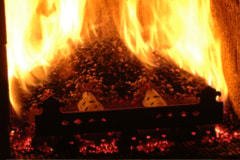Fossil fuels are one of the more common necessary evils of modern life.
And as cool weather begins to descend upon us again, it’s only a matter of time before the depths of winter hit full-force, and the very lives of millions of Canadians become dependent, once again, on burning oil or natural gas.
Burn something or die is the harsh reality of life at our latitude during winter, but the burning needn’t cost us a fortune nor slowly eat away at the viability of our planet. Part of the answer is wood heat, but not necessarily in the way you think.
Most Canadians don’t have practical access to firewood nor the space and inclination to store and handle it, but wood heating pellets offer a way around that difficulty. They’re much easier and cleaner to handle than cordwood, though there’s a problem. Or rather, there used to be a problem. Pellets typically require a special stove to burn them, though not any more.
Wood heating pellets are made of highly compressed saw dust — typically from reclaimed sawmill waste — but one of the challenges of using them has been the high cost of pellet burning stoves. Typically priced 300 per cent to 400 per cent more than a conventional woodstove, this fact has kept more than a few people from even trying pellets. London, Ont. resident Brad Palmer was one of them, but instead of giving up, he got busy.
Brad’s frugal by nature, and that stopped him from forking out thousands of dollars for a pellet stove when he and his wife found conventional wood heating too troublesome and messy.
But what about burning wood pellets in their ordinary wood stove? He tried it and found that a heap of pellets burned poorly — really poorly — about the same as a phone book or pile of old magazines. The problem was air. It couldn’t get into the heart of the pile, so pellets simply sat there and smoldered more or less uselessly. At least they did until he invented an elegant and simple way around the problem. Now pellets burn pretty good.
After hundreds of hours experimenting with different designs in his home workshop, Brad invented a simple, metal grate — he calls it the Bradley Burner. It admits air into a pile of pellets, allowing them to burn cleanly in any ordinary air tight woodstove or fireplace insert.
His idea is now patented and for sale online, and I know from personal experience that it works every bit as well as it’s supposed to. I’ve posted an online video on my website (www.stevemaxwell.ca) where you can see the grate in action.
The Bradley Burner (www.bradleyburner.com; 877-746-7764) is a stacked crisscross of stainless steel angle irons with holes drilled in them.
The triangular shape of each piece of metal allows air to penetrate the pile, enabling the pellets to catch fire and burn cleanly. Pile some pellets on top — I found a two-kg or three-kg heap works best to start — squirt some gel fire started onto the pellets at the front — then light it.
The flames slowly work backwards over the next 15 minutes until the whole pile is on fire. When the initial pile burns down, add more pellets on top of the coals with a metal scoop. Stoked correctly at night, an air tight woodstove or insert should still have burning pellet embers in the morning.
Reducing our dependence on fossil fuels won’t be easy, and it won’t all come from one big change in the way we live.
Heating with wood pellets represents one small shift in the right direction, and it’s growing in popularity so much that certain areas are currently facing seasonal shortages of supply.
But the marketplace is responding with increased production, and that’s a good thing. Pellet heat reduces our reliance on volatile and finite fossil fuels, it lets us heat without contributing to the greenhouse effect, and it gives more and more people the chance to enjoy an exquisite wintertime pleasure — snuggling up to a warm, glowing woodstove.
Steve Maxwell is Canada’s award-winning home improvement expert, and technical editor of Canadian Home Workshop magazine. Sign up for his free homeowner newsletter at www.stevemaxwell.ca
